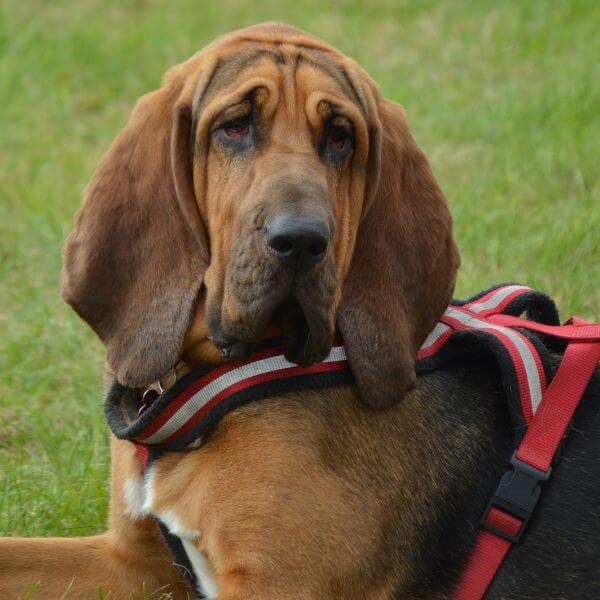PetMeetly helps you find a perfect breeding mate for your Bloodhound
PetMeetly is a highly-rated platform that allows Bloodhound dog owners and breeders to conveniently and swiftly locate an appropriate breeding partner for their cherished pets, using a powerful search algorithm that takes into account essential factors like location, age, gender, and health to identify the best potential breeding partners in your area.
Petmeetly is very user-friendly and allows you to set up a detailed profile for your Bloodhound that includes images and critical health and behavioral information, as well as the ability to browse through other profiles and reach out to owners for further exploration of potential breeding opportunities.
With PetMeetly, you can rest assured that you will find the perfect breeding partner for your Bloodhound, who can enhance your pet’s genetic health and produce robust, healthy puppies.
Join the platform today to find the ideal breeding mate for your Bloodhound.
Tips for breeding a Bloodhound
It’s essential to ensure that you’re engaging in responsible breeding practices to maintain the health and well-being of the parent dogs and their puppies. That’s where this dog breeding checklist comes in handy! This comprehensive guide provides all the information you need to make informed decisions throughout the breeding process, from selecting healthy parent dogs to providing proper care for the puppies.

- Health testing
Before breeding any Bloodhounds, several health tests should be performed to check for any hereditary health concerns. Testing for hip dysplasia, elbow dysplasia, and eye abnormalities, among other health concerns, is recommended by the American Kennel Club. Breeding dogs with excellent health histories may help lessen the likelihood of health issues being passed on to their progeny.
- Temperament
Bloodhounds are noted for their calm, easygoing, and friendly personalities. When considering breeding dogs, it’s important to ensure that their puppies are well-behaved and make suitable household pets. One crucial step in this process is to thoroughly examine the temperament and behavior of the potential breeding dogs before any mating occurs.
- Conformation
Following a breed standard helps maintain the physical appearance and structure of Bloodhounds. This can result in desirable traits like a strong bone structure, healthy coat quality, and a balanced overall appearance.
- Genetic Diversity
Bloodhounds are prone to particular health disorders due to a lack of genetic variation due to their tiny breeding pool. Breeders must carefully examine their dogs’ pedigrees to ensure that they are not breeding closely related canines. Genetic testing may also be used to detect possible health problems.
- Nutrition and Care
Proper nourishment and care are essential for the health and well-being of both breeding canines and their pups. Dogs who are pregnant or nursing should be fed high-quality food and get suitable prenatal and postnatal care. Puppies should be socialized and get necessary veterinary treatment, such as immunizations and deworming.
Pedigree Analysis
The Bloodhound is a well-liked canine breed recognized for its notable size and distinct attributes, characterized by a smooth, glossy coat and a robust physique. The following are some of the breed’s defining characteristics:
Coat
Size
Temperament
Intelligence
Health
Grooming
Energy
Meet our Bloodhounds
Finding a reputable Breeder
Finding a reputable breeder who values the health and well-being of their dogs is critical if you want to breed Bloodhounds. Here are some pointers for locating a Bloodhound breeder:
- Research breed standards:
Before you begin your search, it’s critical to grasp the Bloodhound breed requirements. Bloodhounds are a huge breed with wrinkled, drooping ears and a wrinkled, droopy face. They have a strong sense of smell and a loud, melodic bark. Knowing the breed standards can assist you in evaluating prospective breeders and ensuring that they are producing dogs that satisfy these requirements.
- Check for health testing:
Bloodhounds are prone to various health problems, including hip dysplasia, bloat, and ear infections. Look for breeders that do health exams on their dogs, such as hip and elbow screenings and bloat and ear infection testing, to guarantee they are producing healthy dogs. The breeder should be prepared to give paperwork to back up the findings of the tests.
- Look for breed-specific characteristics:
Bloodhounds have a keen sense of smell, which makes them ideal trackers and hunting partners. Look for breeders that value these characteristics and create dogs with a keen sense of smell and tracking skills. A breeder who engages in canine activities like tracking or hunting might be a strong indicator that they value these characteristics.
- Visit the breeder’s facility:
If feasible, pay a visit to the breeder’s facility to inspect their dogs and living circumstances. Look for facilities that are clean and big, with lots of possibilities for interaction and exercise. The dogs should be well-behaved and sociable.
- Request references:
Request recommendations from past puppy purchasers or other breeders with whom the breeder has dealt. Contact these references to learn about their interactions with the breeder.
- Discuss breeding goals:
Inquire about the breeder’s breeding goals and mindset. They should be able to explain why they selected to breed their specific canines and what they expect to accomplish via their breeding program.
- Contracts and guarantees:
Make careful to review the breeder’s contracts as well as any assurances they provide. A respectable breeder should provide a health guarantee and be prepared to accept back any dogs produced by them if the new owner is unable to care for them.
Find the best match for your Bloodhound
